I am attempting to rewrite my ForestPad application utilizing WPF for the presentation layer. In WinForms, I am populating each node programmatically but I would like to take advantage of the databinding capabilities of WPF, if possible.
In general, what is the best way to two-way databind the WPF TreeView to an Xml document?
A generic solution is fine but for reference, the structure of the Xml document that I am trying to bind to looks like this:
<?xml version="1.0" encoding="utf-8"?>
<forestPad
guid="6c9325de-dfbe-4878-9d91-1a9f1a7696b0"
created="5/14/2004 1:05:10 AM"
updated="5/14/2004 1:07:41 AM">
<forest
name="A forest node"
guid="b441a196-7468-47c8-a010-7ff83429a37b"
created="01/01/2003 1:00:00 AM"
updated="5/14/2004 1:06:15 AM">
<data>
<![CDATA[A forest node
This is the text of the forest node.]]>
</data>
<tree
name="A tree node"
guid="768eae66-e9df-4999-b950-01fa9be1a5cf"
created="5/14/2004 1:05:38 AM"
updated="5/14/2004 1:06:11 AM">
<data>
<![CDATA[A tree node
This is the text of the tree node.]]>
</data>
<branch
name="A branch node"
guid="be4b0993-d4e4-4249-8aa5-fa9c940ae2be"
created="5/14/2004 1:06:00 AM"
updated="5/14/2004 1:06:24 AM">
<data>
<![CDATA[A branch node
This is the text of the branch node.]]></data>
<leaf
name="A leaf node"
guid="9c76ff4e-3ae2-450e-b1d2-232b687214aa"
created="5/14/2004 1:06:26 AM"
updated="5/14/2004 1:06:38 AM">
<data>
<![CDATA[A leaf node
This is the text of the leaf node.]]>
</data>
</leaf>
</branch>
</tree>
</forest>
</forestPad>
